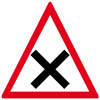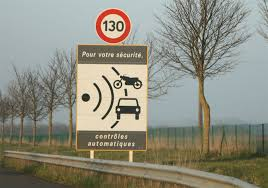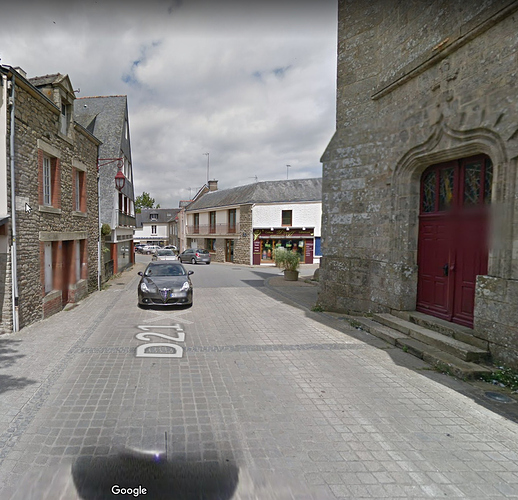This will be where priorité à droite exists…
The most important sign is this one 
In the absence of any signage it is only safe to assume pàd…
It is also important to be able to recognise the enormous warning signs indicating that there may or may not be a speed camera ahead. I know it looks like a warning to look out for low flying motorcycles at roundabouts, but that’s the way it is.

There are also sneaky mobile police speed checks with no warning at all, but helpful drivers will often give you a flash.
Motorway signs tell you the name of the next village (that you have never heard of) and the name of a town hundreds of miles away (that you have vaguely heard of). Anywhere in between you will have to find out from your map reading navigator.
One of the most important things to learn. May not be many of them now, but when someone drives straight at you out of a side road it can be alarming. And any accident will be your fault.
just to “third” the remark; “priorité à droite” is more important to learn than anything else on the above list! 
“… spoilt be French drivers” that works both ways and I look at it the other way when I’m late for work or an appointment “spoilt by bimbling foreign drivers and tourists” 
I canot deny that I ‘bimble’. Smiles. However, I do routinely pull over to ‘clear my baffles’ of frustrated drivers stuck behind me.
-
on anything smaller than an “N” the idea that the French drive on the right is somewhat notional (y’see, them’s more guidelines…) - expect oncoming traffic in the middle of the road. It usually moves back to its own side.
-
Not to labour the point but expect priorité à droite basically anywhere there is no give way/stop sign or line - especially in towns. Do not expect it to be applied consistently - i.e one day approaching a “T” along the “main” road you will find someone pulling out of the side road expecting you to yield; approach the same junction another day along the side road and someone will be hammering along the main road with no intention of giving way to you (this will happen *even* *if* it is not immediately obvious that you are not French).
But it can be a useful way of getting rid of a useless old crock at the expense of some other guy’s insurance.
Happened to a visiting friend from the UK. The view down the side road was obscured by buildings, so it was impossible to see it coming at speed until it was too late.
Probably well known to the local “crash for cash” specialists!
Not advocating people ignore the speed limits are you Mike😀
It’s mad that PàD operates in situations like that - for instance the junction here
operates as PàD, the Google Maps images actually makes things seem better than they are in reality as the photo was taken with the camera car coming towards the viewer on the left as we are looking at the scene. Driving on the right, the building on the corner after the church is not visible at all from that vantage point until you have advanced past the butress.
In sunny weather you sometimes get a clue as you can see the shadow of any vehicle approaching from the right before the vehicle itself - otherwise the only thing to do is approach cautiously.
Perish the thought, but anyone can be guilty of an occasional moment of inattention!
‘French drivers’ is an unhelpful generalisation - here in Brittany I find most drivers very thoughtful - and they compare very favourably with most Brits or other parts of France.
More noticeable than any regional or national difference to me, though, is the difference between urban and rural driving.
Understand your concern on that junction @anon88169868 but the origin of the pàd was concerning horse driven vehicles… in your example photo, the driver would have no chance of seeing oncoming traffic from the left until well in to the junction - hence the requirement for a pàd whilst travelling along the road with the church on your right 
A rivetting ‘must-read’ guide for newbies, Noel!
My own suggestion for additional material is this:
Cake-like structures are prominent on most auto-routes and other major dual-carrageways, situated in the angle formed by the major road and the slip-road exit.
These are low, wedge-shaped structures with a strikingly cake-like appearance in their contours, reminiscent of a soft sponge slice with pistachio fondant icing.
Their function is ambiguous, but such temptations have been known to evince distracting comments from small children in approaching them as, “Can we stop for cake Daddy/Peut-on s’arrêter pour le gâteau papa ?” or “Papa pourquoi ce gâteau-là se trouve-t-il au coin ? J’en ai faim” And similar.
Well, yes - in the days of horse drawn carts.
De nos jours however it would be better to place a clear give way sign.
I expect that the locals just shrug and say “it’s always been like that” - certainly it’s all in a 30km/h zone and, in fact, there is a side road just before the church as well which is also PàD but with much more visibility into the road - so most sensible drivers are already going very slowly by the point that I indicated.
I was living in France when they introduced this in '81 or '82. A bus load of kiddies had lost their lives on an autoroute in the rain. If I remember correctly.
I’d like to add roundabouts. In the UK I would approach a roundabout cautiously, maybe even stopping before entering the roundabout. That’s the wrong thing to do here. You must barrel into the roundabout and attempt to dovetail with the cars already circling. An irate woman got out if her car once and berated me for my cautious approach, I started observing and she was right, press on.
The other thing is the the lane you enter a roundabout by has nothing to do with the lane or the exit you leave it. Cutting people up seems totally acceptable, no beeping etc. I still choose the appropriate lane but keep an eye out for others who (according to my little mind) don’t.
Originally the dreaded priorité à droite operated at roundabouts - giving priority to traffic entering the roundabout over traffic already on the roundabout - chaos (and occasional gridlock) tends to ensue which is why most roundabouts now have give way signs giving conventional priorities. You still get some in cities which operate the “old way” - including I believe the “roundabout” at the arc de triomphe.
Given two lane approaches and (optionally) exits “the French”1 really have not cottoned to the idea of approaching in the left hand lane to turn left - as you I normally do so, but it does, I completely agree, require a high degree of concentration.
1] accepting all the limitations of this generalisation.
I remember driving around the Arc de Triomphe in my little Autobianchi A112 in those exciting days. Roundabouts aren’t half as much fun anymore.
I wish someone had given me a list of 24 hour petrol stations before I first drove here. Not needed now that we have all the new motorways and 24 hour pumps at supermarkets, but 35 years ago it would have been a godsend.
These days the most important thing is to understand that signals given by other drivers at / in / or approaching roundabouts are invariably wrong (including driving school cars!).
I’d like to add pulling out onto a main road into a queue of slow moving traffic. You need to be very patient. No-one will let you out. Until someone finally does, and that catches you completely by surprise.
You just reminded of the days when it was impossible to buy petrol on a Sunday and all shops were closed for 2 hours in the middle of the day!
